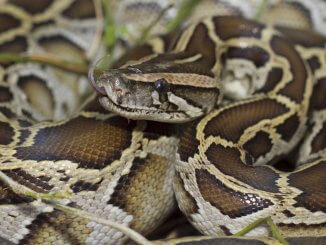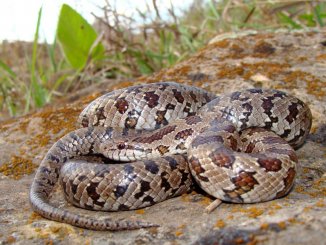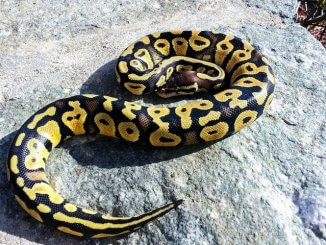The desert kingsnake is a large, slender, nonvenomous species of kingsnake native to Texas, Arizona, and New Mexico in the United States. Desert kingsnakes have dark brown or black bodies with yellow patterning.
Caring for these snakes is easy as long as the snakes are handled gently and housed in clean enclosures that mimic their natural habitat.
Desert Kingsnake Overview
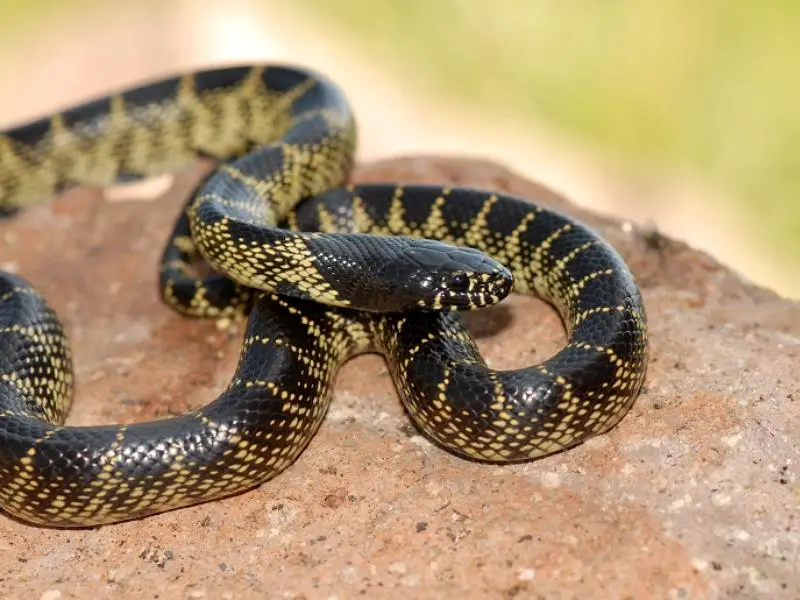
| Common name | Desert kingsnake, desert king snake, common kingsnake |
| Scientific name | Lampropeltis splendida |
| Natural habitat | Rural, semi-arid habitats, such as deserts, grasslands, abandoned farms, and woodlands in Arizona and New Mexico, USA |
| Adult size | 21–78 inches |
| Average lifespan | 10–15 years |
| Diet | Carnivore |
| Housing | Minimum 30 gallons, 68–90°F, 50–75% humidity |
| Experience level | Beginner |
Origin
The desert kingsnake (Lampropeltis splendida) is commonly found in rural, semi-arid habitats, like grasslands, abandoned farms, woodlands, and deserts in Arizona and New Mexico. Despite its name, the snake isn’t a desert species and often inhabits areas close to bodies of water.
In the wild, desert kingsnakes aren’t arboreal — meaning that although they can climb, they usually choose not to. Instead, the snakes burrow into the ground, bask in the sun, and swim to catch their prey.
Appearance and Behavior
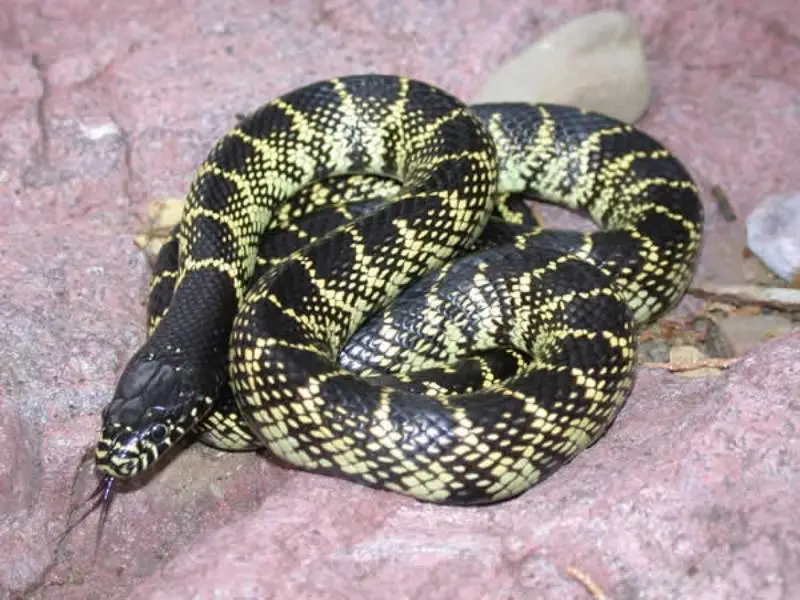
Desert kingsnakes are black or dark brown with smooth, glossy scaleless crossbars, in either yellow or white. These crossbars span from head to tail. The exact color, pattern, and width of the bands are unique to each individual snake. The snake’s abdomen is mostly black, with yellow or white markings on the outsides of the ventral plates.
Male and females are the same color, but adult females are larger than males.
Size and Lifespan
The average size of a fully-grown desert kingsnake is 21–78 inches. Hatchlings are about 8 inches long.
In captivity, desert kingsnakes live for 10–15 years. With good care, the snakes can live beyond 20 years.
Temperament
Desert kingsnakes are confident but not aggressive, with a high prey drive. The snakes can be tamed with regular handling and a good feeding regime.
The species prefers to live alone. For breeding purposes, only house the snakes in groups of one male and one female, or one male and two females, in a large enclosure.
Desert kingsnakes are known to be more likely to bite than other snake species, especially when the kingsnakes are stressed. Loud noises, sudden movements, and cramped living conditions are all known to stress these snakes.
Housing Desert Kingsnakes
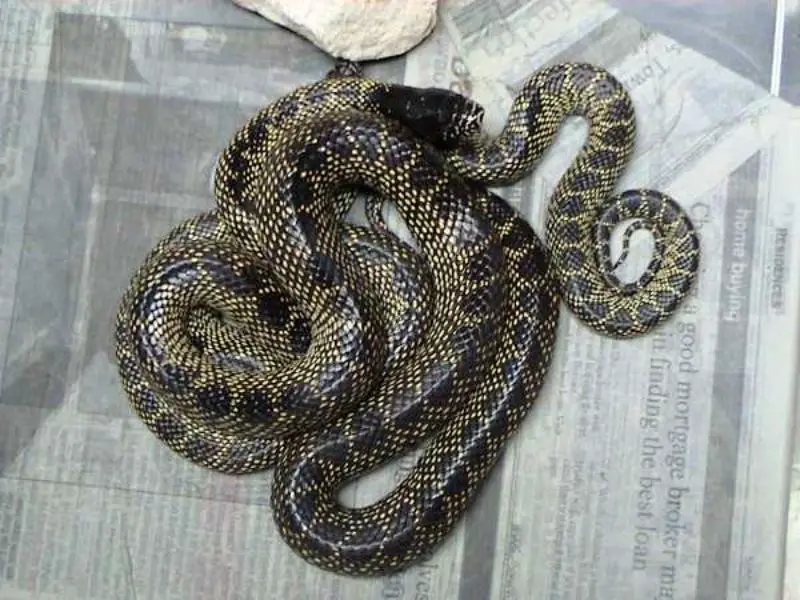
The desert kingsnake’s natural environment is sandy, grassy, or woody habitats in hot, humid regions. Decorate and heat the enclosure to match the snake’s wild habitat.
Keep a desert kingsnake in a medium-sized wooden vivarium with adjustable vents to control the heat and humidity.
Enclosure size
A full-sized desert kingsnake needs an enclosure of at least 30 gallons. The snake prefers to explore its surroundings on the ground, but the enclosure should still have enough height to accommodate a deep layer of substrate for burrowing.
Ideal measurements for a desert kingsnake’s enclosure are 40 inches long by 18 inches high.
Lighting
Special UVB lighting isn’t necessary for a desert kingsnake’s tank because snakes don’t need UVB to absorb calcium. However, these snakes receive UVB from sunlight in the wild, so UVB lighting can be used to replicate the conditions in the snake’s natural habitat if preferred.
The snake needs about 10 hours of daylight per day. To create a day-to-night cycle in the enclosure, place a fluorescent bulb on the underside of the enclosure’s lid, and set it to switch off overnight. If the enclosure is kept in a room that receives full sunlight, extra lighting isn’t necessary.
Temperature and Humidity
In the wild, desert kingsnakes regulate their internal body temperature by moving between cool, shaded areas and warm basking spots. Allow the snakes to perform this thermoregulation in captivity by establishing a temperature gradient.
Two-thirds of the tank should be the cool section, with a temperature of 80°F during the day and 68–75°F overnight. Monitor the temperature with a thermometer.
The other one-third of the tank should be the hot section. Place a heat source, like a basking lamp, in this section to heat the tank to 90°F. An under-tank heat pad can also be used to warm up the basking area, but don’t use hot rocks that could damage the snake’s skin.
The enclosure’s humidity should be between 50% and 75%. Monitor the humidity levels with a hygrometer. Place a large water bowl in the tank to keep humidity levels within the desired range and mist the tank several times per day if necessary.
Desert kingsnakes need high humidity to comfortably shed their skin. Mist the tank more frequently than usual to increase the humidity to 75% while the snake is shedding.
Substrate and Decoration
The best substrate for a desert kingsnake tank is a natural substrate that’s soft enough for the snake to burrow in, such as Cypress mulch and aspen bedding. The substrate should be at least 3 inches deep to allow the snake to burrow.
Sphagnum moss can be scattered onto the substrate to retain moisture. Plain paper towels or newspaper is an inexpensive, easy-to-clean substrate for low budgets. Don’t use sand or pebbles that could be ingested by the snake, and don’t use pine or cedar substrates because the oils from these substrates are dangerous to the snake’s health.
Decorate the enclosure with large rocks, hides, caves, and artificial plants to provide shade, hiding spots, and places for the snake to sleep. Flat rocks can be placed in the basking area, providing a warm spot for the snake to bask on.
Cleaning
A clean enclosure reduces the risk of stress and illness in desert kingsnakes. Spot-clean the enclosure once a day. To spot-clean, remove waste and leftover food, and replace parts of the substrate as necessary. Clean and refill the water bowl.
Deep-clean the enclosure once a week. First, relocate the snake to a temporary enclosure, then empty out the home enclosure and soak the decorations in hot water and dish soap. Sponge down the inside of the enclosure with warm, soapy water, then wipe it dry with a clean cloth.
Add a fresh layer of the substrate to the enclosure, return the plants and decorations, and transfer the snake back into the clean tank.
For stubborn stains, use equal parts white vinegar and water. Never use harsh chemical cleaners that could cause respiratory problems in the snake.
Desert Kingsnake Care
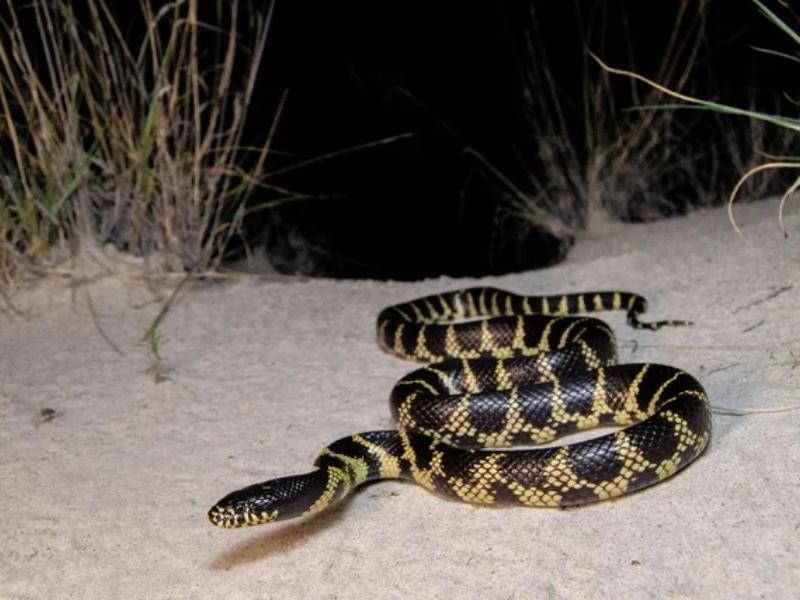
Desert kingsnakes need a clean enclosure, regular handling, and a healthy, high-protein diet.
Food and Water
Adult desert kingsnakes should be fed once per week. Choose a frozen and defrosted rat or mouse that’s the same size or slightly bigger than the snake’s girth. Young desert kingsnakes should be fed a pinkie mouse every four days.
Don’t feed the snake live food as live animals could injure the snake.
Leave a water bowl in the enclosure to give the snake constant access to a clean water supply.
Handling
Desert kingsnakes can be handled, and handling is recommended to tame the snake and get it used to human touch. The snakes generally tolerate handling, but proper handling is essential to prevent them from lashing out and biting.
To handle a desert kingsnake, follow these steps:
- Wash your hands, then lower them into the enclosure and place them on the substrate. Repeat this several times per day to accustom the snake to your presence
- After a week, slowly slide your hands underneath the snake, with one hand supporting the bottom third of the snake, and the other hand just behind the snake’s head. Gently lift the snake out of the enclosure
- Support the snake’s body in your arms. The snake will loosely wrap itself around your arms to anchor itself in place. Don’t squeeze or restrain the snake, which could cause it to become stressed
- Return the snake to the enclosure after 10 minutes. Repeat steps 2 and 3 once per day
Desert kingsnakes become overstimulated by loud noises and sudden movements, so be slow and quiet during handling, and supervising children at all times.
Common Health Issues
There are several health conditions affecting desert kingsnakes in captivity, including the following.
Respiratory Infections
Respiratory infections, like colds and pneumonia, are caused by suboptimal temperatures in the snake’s enclosure. Wheezing and open-mouthed breathing are signs of respiratory infections according to VCA. To treat the infection, make sure the temperature in the enclosure is correct and speak to your veterinarian about antibiotics.
Parasites
External parasites like ticks and mites can be transported into the tank by foods or decorations that haven’t been properly sanitized. Parasite infestations look like black or white dots on the snake and in the enclosure.
Treat ectoparasites in captive reptiles by thoroughly cleaning out the tank and sanitizing all decorations, and using commercial parasite treatments on the snake.
Breeding
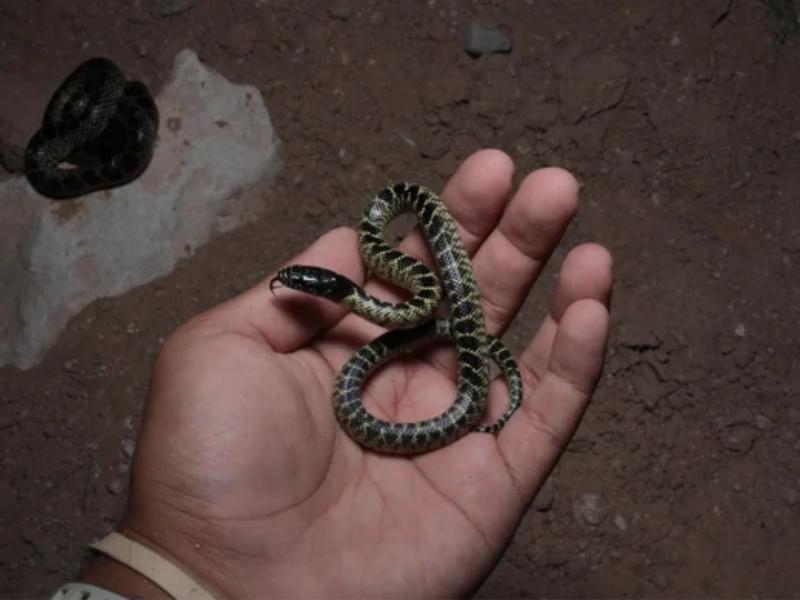
Breeding desert kingsnakes in captivity is easy. The snakes become sexually mature at three to four years old.
To breed a pair of desert kingsnakes, follow these steps:
- Select one healthy, well-fed male and female for breeding
- Condition the snakes by not feeding them for 15 days. Establish a separate breeding enclosure with the same temperature and decorations as the home enclosures
- Put the male and female into the breeding enclosure. Gradually reduce the temperature in the enclosure to around 70°F
- Monitor the male and female and wait for them to breed, which could take a few days. Copulation takes between 10 minutes and several hours
- Once the snakes have finished mating, remove the male from the enclosure. The female will be gravid (pregnant) for up to 70 days
- The female will lay between 5 and 12 eggs. Place the eggs in an incubator for up to 60 days until they hatch
- Wait several days until the hatchlings shed for the first time, then begin feeding them pinkie mice every four days
- When the hatchlings are six months old, transfer them to their own separate enclosures and begin feeding them adult food
Choosing and Buying a Desert Kingsnake
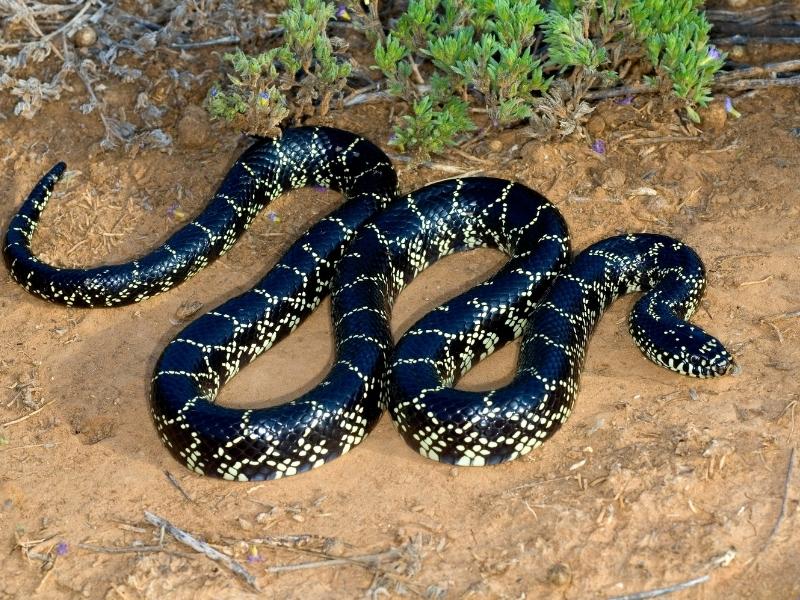
The average cost of a desert kingsnake is $150–$300. This species is available at pet stores, but buying from a reputable breeder is recommended to guarantee a healthy, expertly-raised snake.
Desert kingsnakes are commonly available in the US. Look for captive-bred snakes that are more docile and used to humans than wild-caught snakes. When choosing a desert kingsnake, check that the snake’s scales are smooth and shiny, and its eyes are clear and alert. Ask the breeder if you can watch the snake feeding to ensure it’s eating properly.
Avoid snakes with signs of poor health, like cloudy eyes, marks, redness, or swollen scales.

